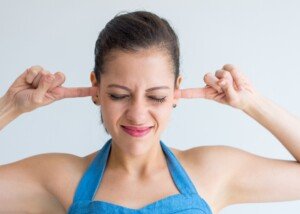Absolutely ridiculous: the volume level of music at indoor trampoline parks.
Where has it been proven that kids can’t have fun without super loud sound systems?
I’ve been to two different indoor trampoline parks. My jammed-in, custom-made earplugs were barely enough to make the roaring volume of the music tolerable.
This isn’t an issue of being “sensitive” to loud noise. I’ll bet if I had a decibel meter, it would clock at least 100 dBs, possibly 105 dBs – and that is LOUD.
A dB is a unit of sound volume.
Kids today have been brainwashed into thinking that having fun requires roaring music.
When I was a kid, there was no such thing as blaring music at indoor fun places.
You might be wondering why I don’t just let it go as long as the earplugs work.
Well, the earplugs barely work; I have to keep adjusting them because they have a tendency to lose their suction.
I also have to loosen them in order to have conversation. For them to effectively filter out volume, they also filter out the ability to hear someone speaking to me.
Today’s kids are going to be the most hearing impaired generation of adults ever.
Noise Induced Hearing Loss
Noise induced hearing loss (NIHL) in children is an increasing concern due to the prevalence of loud ambient music in various environments.
Kiddos and teens are particularly vulnerable to hearing damage because their auditory systems are still developing, making them more susceptible to long-term effects.
Studies have shown that exposure to high decibel sounds, such as those from loud music in entertainment or activity venues, can lead to permanent hearing damage.
According to the World Health Organization (WHO), exposure to sound levels above 85 dB for extended periods can cause NIHL.
In many social and recreational settings, ambient music often exceeds this threshold.
For instance, sound levels in movie theaters, concerts and even some retail stores can reach 100 dB or more, posing a significant risk to children’s hearing health.
A study published in the Journal of the American Medical Association highlighted that young kids and adolescents who frequently attend events with loud music are at a higher risk of developing hearing problems.
The research indicated that approximately 12.5% of kids six to 19 years have evidence of NIHL in one or both ears, likely due to exposure to loud noise.
Another study in the International Journal of Audiology found that prolonged exposure to loud music through personal listening devices, such as headphones, is also a significant contributor to NIHL in kids and adolescents.
Prevention of NIHL in Your Child
Parents should be mindful of the volume levels in environments frequented by their kids.
The use of hearing protection, such as earplugs or noise canceling headphones, can significantly reduce the risk of NIHL.
But there’s a caveat with earplugs and headphones.
- First off, they interfere with conversation.
- Secondly, many kids won’t wear the headphones because they think these will make them look like sissies or odd.
- Third, many kids will remove the earplugs at some point due to either discomfort or their interference with conversation.
- Nevertheless, parents should encourage hearing protection, just like they require their kids to wear sunscreen.
Educating children about the dangers of loud noise and encouraging them to take breaks from thundering loud environments are crucial approaches.
And last but not least, if parents were vigilant in urging the managers of loud indoor places such as trampoline parks to cut down on the volume, there’s a pretty good chance that staff would do this!
Parents, SPEAK UP!
You need to be as much a warrior regarding the hearing health of your children as you are with the health of their teeth!
References
-
World Health Organization. (2015). “Make Listening Safe” initiative.
-
Basner, M., Babisch, W., Davis, A., Brink, M., Clark, C., Janssen, S., & Stansfeld, S. (2014). Auditory and non-auditory effects of noise on health. Lancet, 383(9925), 1325-1332.
-
Niskar, A. S., Kieszak, S. M., Holmes, A. E., Esteban, E., Rubin, C., & Brody, D. J. (2001). Prevalence of hearing loss among children 6 to 19 years of age: the Third National Health and Nutrition Examination Survey. JAMA, 279(14), 1071-1075.
-
Vogel, I., Verschuure, H., van der Ploeg, C. P., Brug, J., & Raat, H. (2009). Adolescents and MP3 players: too many risks, too few precautions. Pediatrics, 123(6), e953-e958.
 Lorra Garrick has been covering medical, fitness and cybersecurity topics for many years, having written thousands of articles for print magazines and websites, including as a ghostwriter. She’s also a former ACE-certified personal trainer.
Lorra Garrick has been covering medical, fitness and cybersecurity topics for many years, having written thousands of articles for print magazines and websites, including as a ghostwriter. She’s also a former ACE-certified personal trainer.
.










































